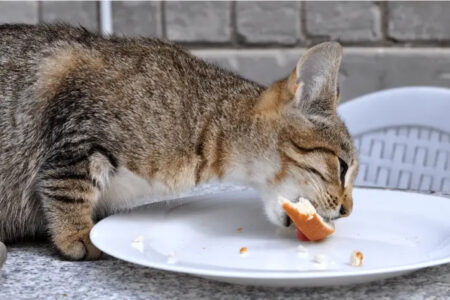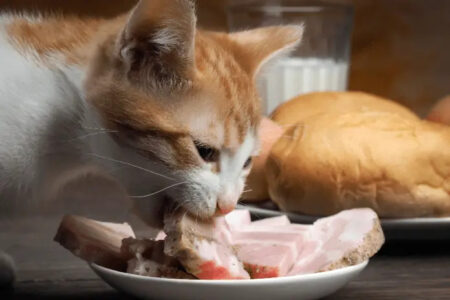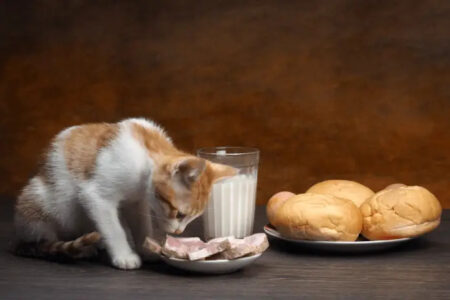Can Cats Eat Bread?
When it comes to feeding our feline friends, it is important to be cautious about what we offer them. One common question that many cat owners have is whether or not cats can eat bread. Bread is a staple food for humans, but can it be safely consumed by cats? In this article, we will discuss whether bread is a suitable addition to a cat’s diet, the potential risks associated with feeding bread to cats, and healthier alternatives to consider.
SEE ALSO: Can Dog Have Coconut?
Can Cats Eat Bread?
Cats can technically eat bread, but it is generally not recommended as a regular part of their diet. Bread does not provide any significant nutritional value for cats and can even pose some risks to their health.
One concern is that bread is high in carbohydrates, which can lead to weight gain and obesity in cats. Cats have different dietary requirements compared to humans, and their bodies are designed to digest meat-based proteins rather than carbohydrates. Feeding bread to cats regularly can disrupt their natural nutritional balance and contribute to health issues such as diabetes.
Another problem with bread is that it often contains ingredients that are harmful to cats. Many types of bread, especially those made with yeast or certain flavorings like garlic or onion, can be toxic to cats. These ingredients can cause digestive upset, stomach pain, or even more severe conditions such as anemia or organ damage.
Additionally, bread can be a choking hazard for cats, especially if it is given to them in large pieces or without being properly moistened. The dry, crumbly texture of bread can easily get stuck in a cat’s throat, leading to choking or other respiratory issues.
Can Cats Eat Bread Dough?
It is important to note that cats should never consume bread dough. Raw bread dough can be extremely dangerous for them. The reason behind this is that raw dough contains yeast, which can continue to ferment and produce alcohol in a cat’s stomach.
Why Do Cats Love Bread?
Cats are known to have a preference for bread, and many cat owners have witnessed their furry friends stealing a piece of bread or showing a strong interest in it. However, it is important to note that bread should not be a staple in a cat’s diet as they require a balanced and specific nutritional intake.
There are a few reasons why cats may be drawn to bread:
- Texture: Cats have a keen sense of texture, and the soft, doughy texture of bread may be appealing to them. It could provide them with a different sensory experience compared to their regular dry or wet cat food.
- Smell: Bread, especially freshly baked bread, has an enticing aroma that can attract cats. Their sense of smell is highly developed, and the scent of bread may be intriguing to them.
- Yeast: The yeast used in bread dough produces ethanol, which can create an intoxicating effect on cats. This can cause them to be attracted to bread and even develop a temporary addiction to it. However, this is not a healthy behavior, and bread should not be given to them as a treat.
Which Types Of Bread Are Safe For Cats To Eat?
- If you want to offer your cat a small taste of bread as an occasional treat, there are a few types that are safer for them to consume:
- Plain, unsalted bread: A small amount of plain bread without any added salt or spices is safe for cats to eat. Make sure it is not a flavored or seasoned variety, as ingredients like onion or garlic can be toxic to cats.
- Whole grain or whole wheat bread: These types of bread contain more fiber and nutrients compared to white bread. However, keep in mind that cats are obligate carnivores and primarily need animal protein, so bread should not replace their regular diet.
Which Types Of Bread Are Not Safe For Cats To Eat?
Certain types of bread are not safe for cats to eat and should be avoided altogether:
- Bread with additives: Bread that contains additives such as onion, garlic, raisins, or other toxic ingredients should never be given to cats. These substances can be harmful to their health and may cause gastrointestinal upset or even toxicity.
- Bread with seasonings: Flavored bread with spices, herbs, or salt should not be given to cats. Cats have a low tolerance for excess salt, and consuming heavily seasoned bread can lead to dehydration and other health issues.
- Sweet bread: Bread that contains sweeteners, such as sugar, honey, or artificial sweeteners, is not suitable for cats. Cats lack the necessary enzymes to digest sugars properly, and consuming sweet bread can lead to digestive upset and potential weight gain.
Things to Know Before Feeding Your Cat Bread
If you’re considering giving bread to your cat, here are a few important things to keep in mind:
- Consult with a veterinarian: Before introducing any new food item to your cat’s diet, including bread, it is recommended to consult with a veterinarian. They can provide personalized advice based on your cat’s specific needs and health conditions.
- Bread is not a nutritional necessity: Cats are obligate carnivores, meaning their bodies are designed to thrive on a diet primarily composed of animal-based proteins. Bread does not provide the essential nutrients that cats need, so it should not be a significant part of their diet.
- Monitor portion sizes: If you decide to offer your cat a small piece of bread as an occasional treat, be mindful of portion sizes. Too much bread can lead to digestive upset, weight gain, and other health issues. Keep servings very small and infrequent.
- Watch for allergic reactions: Some cats may have allergies or sensitivities to certain ingredients in bread, such as wheat or gluten. Watch for any signs of allergic reactions, such as vomiting, diarrhea, or skin irritations. If any of these symptoms occur, discontinue feeding bread immediately and consult a veterinarian.
- Be cautious of yeast dough: Raw yeast dough can pose serious risks to cats. The dough can expand and ferment in their stomachs, leading to bloating and potentially dangerous gas buildup. Never feed your cat raw yeast dough or leave it within their reach.
- Consider the cat’s overall diet: Before offering bread to your cat, consider their overall diet. If they have specific dietary restrictions or health conditions, bread may not be appropriate for them. It is best to prioritize their regular cat food, formulated to meet their specific nutritional needs.
How to Feed Bread to Cats
If you choose to give your cat bread as an occasional treat, here are some guidelines to follow:
- Choose the right type of bread: Opt for plain, unsalted bread without any additives or seasonings. Whole grain or whole wheat bread can be a better choice due to their higher nutritional value.
- Cut the bread into small pieces: Cut the bread into very small, bite-sized pieces or break it into crumbs. This helps prevent choking and makes it easier for your cat to eat.
- Offer bread in moderation: Bread should only be offered as an occasional treat and should not replace your cat’s regular diet. Limit the amount of bread you give to your cat to avoid potential health issues.
- Watch for any adverse reactions: Monitor your cat after feeding them bread. Some cats may have sensitivities or allergies to certain ingredients in bread. Watch for any signs of upset stomach, vomiting, diarrhea, or allergic reactions. If any of these symptoms occur, discontinue giving bread and consult a veterinarian.
- Avoid feeding raw yeast dough: Never feed your cat raw yeast dough as it can expand in their stomach and cause serious health complications. Keep all raw dough securely away from your cat’s reach.
How Much Bread Can A Cat Eat?
Small amounts of baked bread are generally okay for cats to eat in moderation.
Benefits of Feeding Cats Bread
Feeding bread to cats can provide a few potential benefits, although it is important to note that bread should not be a significant part of a cat’s diet. Here are a few potential benefits:
- Variety and enrichment: Offering a small piece of bread as an occasional treat can provide cats with a different texture and flavor experience. It can enhance their mealtime and add a sense of enrichment to their diet.
- Bonding and socialization: Sharing a small piece of bread with your cat can be an opportunity for bonding and strengthening the human-animal bond. It can create positive associations and interactions between you and your cat.
- Satisfying their curiosity: Cats are naturally curious animals, and offering them a taste of bread can help satisfy their curiosity and desire to investigate new objects or smells. It can provide mental stimulation and keep them engaged.
Downsides of Feeding Cats Bread
While cats may show interest in bread, it is important to be aware of the potential downsides of feeding them bread:
- Lack of essential nutrients: Bread does not provide the essential nutrients that cats need for optimal health. They require a diet that is high in animal-based protein and contains specific vitamins and minerals. Regularly feeding bread to cats can lead to nutritional imbalances or deficiencies.
- Weight gain: Bread is often high in carbohydrates and calories. Feeding cats bread in excess can contribute to weight gain, which can lead to obesity and associated health problems such as diabetes, joint issues, and decreased overall well-being.
- Digestive issues: Cats have a delicate digestive system. Eating bread, especially in large quantities, can lead to digestive issues such as upset stomach, diarrhea, or constipation. Some cats may also have sensitivities or allergies to wheat or gluten, leading to gastrointestinal discomfort.
- Potential for addiction: Bread contains carbohydrates that can cause a temporary addictive response in cats. They may develop a strong desire for bread and constantly seek it out, leading to unhealthy begging behaviors.
- Masking underlying health issues: Feeding bread to cats can mask underlying health issues or dietary deficiencies.
SEE ALSO: Can Dog Eat Pineapple?
FAQs
Q. Can my cat eat white bread?
A. While cats can technically eat white bread, it’s not a good idea to give them any type of bread, including white bread.
Q. What human foods are safe for cats?
A. There are a few human foods that are safe for cats to eat. Green beans, peas, carrots, and broccoli are all good options, as they provide vitamins and minerals without being too high in calories.
Q. Can cats eat bread crusts?
A. It’s not a good idea to give your cat bread crusts. Bread crusts are made up of the same ingredients as the rest of the bread, which means they’re high in carbohydrates and low in nutrients.
Q. Can cats eat bread and milk?
A. No, cats should not eat bread and milk. Bread is high in carbohydrates, which cats don’t need in their diet.
Q. Can cats eat bread and butter?
A. Just like with bread and milk, bread and butter is not a healthy food for cats. Bread is high in carbs, and butter is high in fat.
Q. Can cats eat brown bread?
A. The short answer is no, cats should not eat brown bread. While brown bread is often considered a healthier option for humans, it’s still made with flour, which is high in carbs and difficult for cats to digest.
Conclusion
In conclusion, cats should not eat bread. Bread is high in carbs and doesn’t provide the nutrients that cats need. Additionally, the ingredients in bread, like yeast and flour, can cause digestive upset in cats. If you’re looking for a healthy snack for your feline friend, try giving them a small piece of cooked meat or fish instead. Remember, always consult with your veterinarian before making any changes to your cat’s diet. With the right nutrition, you can help your cat live a long and healthy life.


